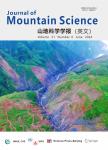Stand structure, floristic composition and species diversity along altitudinal gradients of a Bornean mountain range 30 years after selective logging
Stand structure, floristic composition and species diversity along altitudinal gradients of a Bornean mountain range 30 years after selective logging作者机构:Faculty of Agriculture and Food SciencesUniversiti Putra Malaysia Bintulu Sarawak CampusP.O.Box 39697008 BintuluSarawakMalaysia Forest Department SarawakWisma Sumber AlamJalan StadiumPetra Jaya93660 KuchingSarawakMalaysia
出 版 物:《Journal of Mountain Science》 (山地科学学报(英文))
年 卷 期:2019年第16卷第6期
页 面:1419-1434页
核心收录:
学科分类:0709[理学-地质学] 0819[工学-矿业工程] 07[理学] 0303[法学-社会学] 0708[理学-地球物理学] 0818[工学-地质资源与地质工程] 0705[理学-地理学] 0815[工学-水利工程] 0706[理学-大气科学] 0816[工学-测绘科学与技术] 0813[工学-建筑学] 0704[理学-天文学] 0833[工学-城乡规划学] 0713[理学-生态学] 0834[工学-风景园林学(可授工学、农学学位)]
基 金:conducted under research permit NCCD.907.4.4 (Jld.11)–3 supported by the Ministry of Science, Technology and Innovation Malaysia [Science Fund (06-01-04SF2281)]
主 题:Forest structure Mountain highland Tree diversity Vegetation recovery Bornean mountain
摘 要:The mountain ecosystem is a hotspot of biodiversity and provides a significant contribution to the humans’ livelihoods. However, there is still a lack of information regarding floral diversity and how it has been affected due to a logging operation in Sarawak. A study was conducted to determine vegetation recovery at the Heart of Borneo conservation area at different elevations: 750–1200 m(S1), 1200–1500 m(S2) and 1500 m(S3). A total of 891 trees were enumerated. The trees comprised 55 families, 98 genera and 203 species. The lowest elevation site, S1, contained the highest number of species(117) and families(42), while the highest elevation site, S3, contained the lowest diversity(25 families and 59 species). A similar forest structure was recorded, whereby diameter at breast height(dbh), basal area and height decreased as elevation increased. The most speciose families in S1 were Dipterocarpaceae(11 species) and Lauraceae(10 species), while Lauraceae and Fagaceae were the dominant tree families at S2 and S3. Secondary tree species are still abundantly found in the logged plots, especially at S2(45.5%), indicating that after 30 years, these stands are still in the recovery stages. The logged plots retained typical secondary forest appearances with lower canopy diameters and heights and dbh than the unlogged forest. Although the species richness approached that of the unlogged plots, especially at S1(90.9%) and S3(94.9%), there were still major differences in the floristic compositions between logged and unlogged plots(35.4%, 21.5% and 44.7% for S1, S2 and S3, respectively). Although potential seed sources were in close proximity, succession at S2 has proceeded much slower than at S1 and S3. Lower concentrations of soil nutrients, especially N, may be the main reason for the slow recovery. In conclusion, the results suggested that the selectively logged forest at the Payeh Maga Highland required more than three decades to recover and achieve a climate forest stage.



